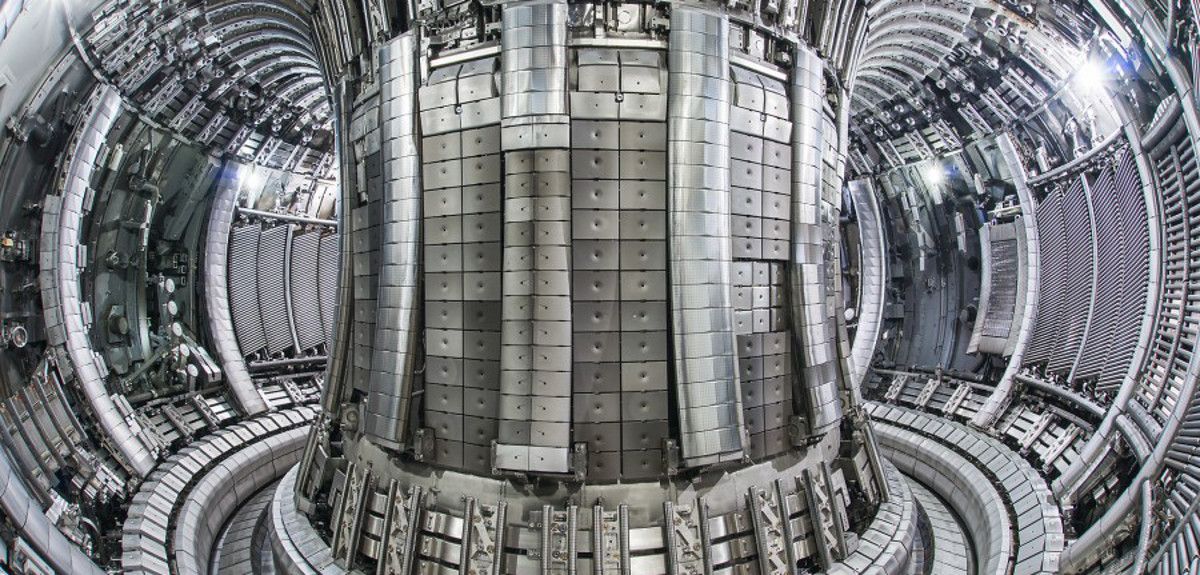
Image by EUROfusion under Creative Commons license.
Testing the thermal tolerance of the fusion reactors of the future
Oxford University researchers have developed a new method that makes it possible to study whether the deterioration of nuclear fusion reactor materials in the face of extreme radiation may cause catastrophic thermal failure.
Nuclear fusion is an attractive option for creating sustainable energy, in principle using the same reactions found at the centre of stars to generate large quantities of power without carbon emissions.
But creating those conditions on Earth is difficult, and part of the problem is finding the correct materials to contain the fierce reactions.
The most common approach is to magnetically contain the high-energy particles, known as a plasma, in a tight circle running through the centre of a giant metal torus. This set-up is employed at the JET facility in Culham, just outside Oxford, as well as in the forthcoming ITER experiment in the south of France.
But even constrained by large magnetic fields, the plasma still subjects the walls of the vessel, likely to be made of tungsten, to extreme conditions.
'It really is pretty horrendous in there', admits Professor Felix Hofmann of Oxford University's Department of Engineering, the lead author of the research. 'The fusion reaction creates intense neutron radiation and extreme temperatures that can easily damage the wall of the torus.
'With the fundamental physics of fusion at least close to being solved, we’re now at a stage where technical implementations, like material choices for future commercial systems, are the main challenge.'
Previous experiments have shown that the variations in temperature at the torus wall can produce cracks and even catastrophic failure.
But Professor Hofmann suspected that the radiation in the reactor might also affect the properties of the material used in the walls, reducing its thermal conductivity — a measure of how well it conducts heat — and in turn increasing the risk of such failure.
So, along with researchers from the Massachusetts Institute of Technology and the Culham Centre for Fusion Energy, his team from the Department of Engineering Science has been carrying out experiments to investigate these effects.
It's not possible for researchers to recreate the conditions of a fusion reactor in the lab — it would be prohibitively expensive as well as dangerous. Instead, Professor Hofmann and his team use samples of tungsten that have been bombarded with high-energy ions as part of the Materials for Fission and Fusion Power project at the Department of Materials Science.
Helium ion bombardment is a good approximation of the conditions that the torus is exposed to, but only creates a very thin layer of irradiated material, making it difficult to use conventional means to measure properties like thermal conductivity.
As a result the team has adapted a technique, previously used to measure the thermal conductivity in silicon semiconductors, known as laser-induced transient grating spectroscopy. This approach uses two short laser pulses that overlap as they hit the sample.
Interference of the light creates a fringe pattern, which causes a temperature grating to form on the sample surface. A third laser beam is used to measure the decay of this temperature grating, which can be used to calculate the thermal conductivity in the thin patch being inspected.
Professor Felix Hofmann
The team then used sophisticated models, developed at the Culham Centre for Fusion Energy, to predict the theoretical changes in thermal conductivity that their experimental studies should generate. 'We were amazed by just how closely the two match up,' explains Professor Hofmann.
The team's results show that even a small amount of irradiation damage can have a dramatic effect on thermal conductivity, reducing it by as much as 50 percent.
'That’s bad news for fusion reactors as it means that their lifetime could be significantly shortened by this effect,' explains Professor Hofmann.
'But the good news is that, with this new approach to measuring thermal conductivity, we at least now have a tool to understand the detrimental effects of the radiation in much more detail.'
The team is hopeful that the technique will allow engineers to choose the most appropriate materials for use in the fusion reactors of the future.
'Fusion power looks set to be one of the main sustainable energy sources in the long term. We need to ensure we can make it a reality, quickly, safely and reliably,' explains Professor Hofmann.
'This finding will allow us to understand the physics and material science required to choose the most appropriate materials for the job.'
The full research paper, 'Non-Contact Measurement of Thermal Diffusivity in Ion-Implanted Nuclear Materials,' is published in the journal Scientific Reports.
 Expert Comment: Can Europe hold the line of liberal democracies?
Expert Comment: Can Europe hold the line of liberal democracies?
 Oxford launches first human aerosol TB challenge trial
Oxford launches first human aerosol TB challenge trial
 Rees Centre report reveals challenges faced by Black and Asian kinship carers
Rees Centre report reveals challenges faced by Black and Asian kinship carers
 Expert Comment: The Modern Slavery Act at 10 – what have we learnt for human rights?
Expert Comment: The Modern Slavery Act at 10 – what have we learnt for human rights?